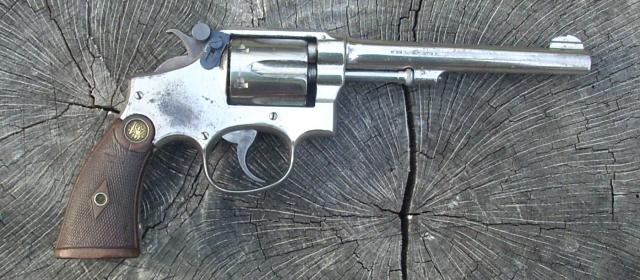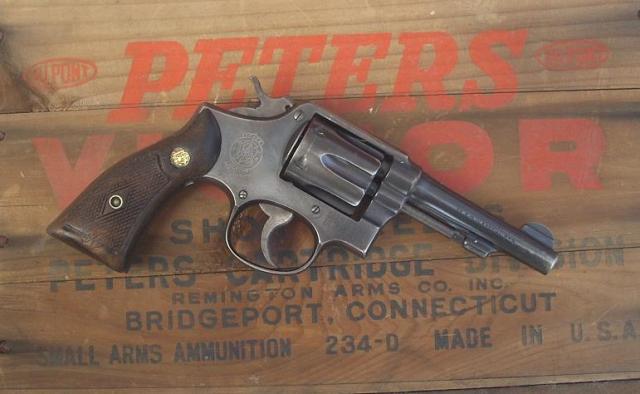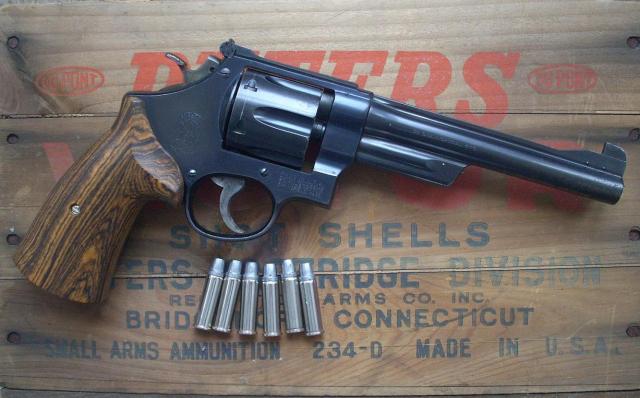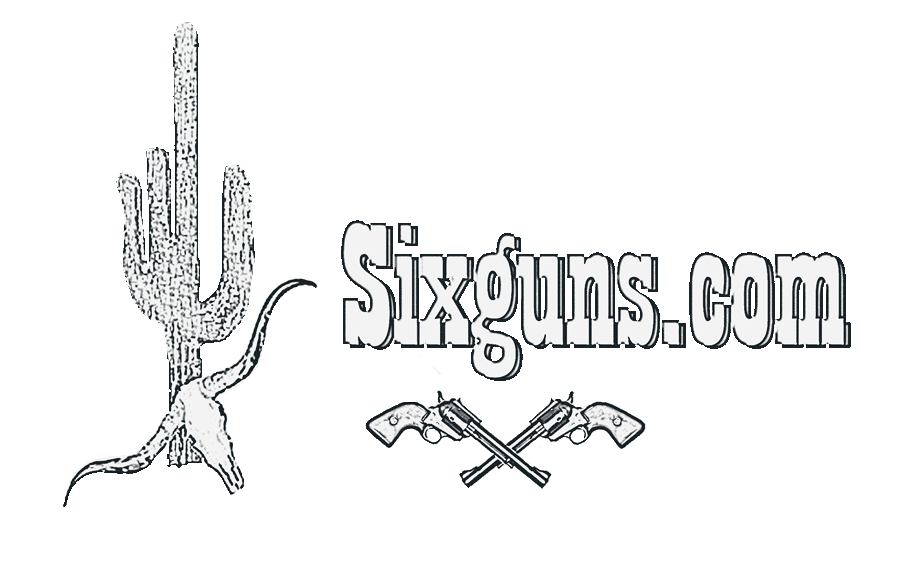I want to have an informal survey of what sights you all prefer on your sixguns. I want to stick with open sights and find out what is the best front and rear combination. I have used everything from partridge, notch rear post front , bead front u-notch rear, Fiber optic front, Vee notch rear etc. etc. but haven't figured what really works best for these old eyes. So let me know what you like. Thanks, Chris
Sight Survey
- Login to post comments
Howdy, Chris. I like a big square notch and a ramped front, even been known to file a tiny little v in the center of the front for those long distance shots with the big revolvers. IPSC gun I have a Heni rear and a F/O front, replaced the light pipe in the front with a brass bead of a very unique profile, kind of dished in with a little tit in the middle. Quick and easy to pick up in any outdoor light condition. Haven't found anything that works that well in dingy, indoor ranges, but that's just worn out old eyeballs I imagine.
Al
ALL BLACK WITH POST FRONT
I have always preferred a black square notch rear and black post front. Due to recent loss of perhaps 95% of my eyesight, I only have a small circle of sight left in my dominant (only) eye. I'm having real problems picking up the front sight against the steel targets when they are painted black. I'm seriously leaning towards a gold bead in the front sight in my future guns. I hate painting the sights but I may go that route with a few just to see how I like them.
mt
mt: My sights have gone thru many stages too. I have tried all kinds and I'm back to the square notch rear and post or partridge front, although I am trying the fiber optic front off and on to see if it helps. Chris
Yeah, I'm resisting fiber optics. I'm not old (49) but I sure am old fashioned.
mt
mt: I am old but I, too, resisted the new stuff for a long time but I felt with my eyes and all if a FOS would help I'd at least try it. So far on my Ruger it is definitely easy to see but not sure if it will help my poor shooting. Chris
Reading this thread got me thinking...that usually doesn't end well. Anywho, I pulled my S&W 586 out of the safe to check the red front insert. I haven't used this gun since I lost my sight and when I pulled it up and sighted on the white wall the red insert looks black. This is going to be interesting, a friend has asked me to go hog hunting this Fall and I will need a front sight I can see against the black bodies.
mt
mt: The red fos is ok but I've had some good luck with the green one also. I think the green shows up in daylight or sunlight better than the red. But the red one does show up at dusk or early or in shadowy light. Chris
Shooting paper at a well lighted range the most accurate for me is black post a square rear and I wear reading glasses to make the front sight clear, but this is not practical for field use with my eyesight..
For years my favorite field sight was an ivory bead in a post with a shallow v rear sight or a regular square rear.
A few years ago I started experimenting with fiber optics and hands down the quickest under variable conditions that I can clearly pick up on are front and rear fiber optics. I prefer the LPA system and have modified a few older Smiths for the two screw tops strap set up. My single actions are still the ivory dot.
Hi safaris: Back in the 70's I happened on a whole slew of 38 special lead round nose ammo and was shooting it up in my Python with the six inch barrel. I fashioned a brass bead front sight to fit it and made a u-notch rear leaf to fit. After some practice I got pretty good plinking with the smooth Colt and started hunting rabbits with it after work in the fall. I got good enough to do head shots at about 25-30 yds and that fall I had around a dozen or more rabbits in the freezer, nothing better than pan fried rabbit in gravy! Lately these eyes have changed so that's why I've been trying different combinations and the Python is sporting a red fiber tube on the front and the white outline notch on the rear. It seems to work pretty decent, a lot better than the red insert on my Colt New Frontier! The red insert seems to blur easy and block out the front sight, might just be me. I have tried a bead front and vee rear notch also and it is fast for snap shooting but I didn't think it was too good on a paper target.I had a white dot front sight on my 45 acp but went back to a sloped front blade and it works ok. Chris
I guess I have always been kinda partial to the bright orange bead that used to be so popular on alot of the Ithaca shotguns in the 70's and 80's. It always seemed to work well for me. Although, I don't think the squirrels cared much for it.
I've used all kinds of sights over the years, and I find they are all a compromise of one kind or another. I still like the simple SAA style sights- trough and blade, because this is about as rugged as it gets. When you use your gun in the field it gets all sorts of attention-from rocks to brush to impacts-even slipping and falling on it. Problem is, in some light, this sight system is darn hard to pick up, and with finely regulated sights, even small changes can have big effects on your accuracy.
I do think that when it comes to accurate shooting, the best system is some type of post front with a slotted rear. The Ruger adjustable sights are a good example here. The problem I have with all adjustable sights is that they are more prone to breakage than the trough and blade. This can be mitigated somewhat by carrying the gun in a holster that covers the sights, but it can't be eliminated entirely. Black sights work well-but so do red inserts on the front post, and white outline rear slots. Once again, nothing is perfect. Black sights will be at their worst under a dark cloudy sky, or long shadow and twilight conditions, and when the snow is deep and the sun shines, the white outline slot takes an extra moment or two to locate.
I've used a green fiber optic front sight, and found it to be so bright as to be annoying. It did nothing for accurate shooting, but it was easy as pie to pick it up quickly. I found the fiber optic would be a great choice for someone who needs bright stuff in difficult lighting conditions, but again, they are even more fragile than standard post & slot sights.
All of this has to do with using sights outdoors, in a variety of light conditions, from my own experience, so I don't claim to have the last word, but if I wanted the best compromise, I would choose the front post, with adjustable slotted rear. If I wanted the toughest, it would be the original SAA style, and if I wanted fastest, I'd opt for a fiber optic of some type.
A subject getting dear to my heart in the last few years. I always had eyesight above the norm. Even today my eyesight is so good that I can see the fuzz that the lazy manufaturers started leaving on the front sights of pistols in the last few years. Even younger folks with supposed excellent vision are unable to see such fine detail. (I will now remove my tongue from my cheek)
I just picked up an autploader that has the shallow "v" with a bead front for the lollipop effect. can't wait to try it.
On sixguns I have never found any of the "normal" variety to be superior, but I regret I never got a chance to try a "custom pistol" that was donated to the Museum where I worked. It was a Colt DA in 32/20. It had the "U" notch (groove) in the rear and a round gold bead up front. You have no idea how I wanted to try it. I can say that it was, theoretically, the overall neatest set of sights, due to the size of the bead matching the notch, that I'd ever seen on a revolver.
I am going to try the Elmer Keith gold bars on my flat top .44 special eventually. I mat start with the flat top .44 mag anniversary first however.
My wife has a 4" S&W 28 (well used) that is missing the front sight insert. I am trying to find the time to make a new insert. the notch is not a "factory notch and it spans nearly the whole length of the blade. I want to try a two-piece insert- maybe brass on top and a contrasting matrial on the bottom. Haven't worked out the details. If I ever get the time I'll take it to my shop and just "wing it" I might take a wild hair and put in a Keith striped insert.
Countrygun, I had a brass insert on my Gold Cup for quite some time and eventually found it lacking, I since have gone back to the black blade front and find it best for the target and what plinking I do now. I also had some white on the front for a bit to try it and found white spot or stripe to be very, very poor for most shooting with the exception of low light when the white shows up. I have gone through all these phases over the years and find myself back where it all started, post and notch. The only other sight that ever worked fairly well was the gold bead front and shallow vee rear I tried for a bit on my Python, but, said python now wears a red FO front for experimenting and so far it works but I think the old post blade would do as well so it may be back on there before long. Sorry for rambling but that's it for me. Chris
Custom sights are often very specialized. I think a good example here is the Novak straight 8, or the X-S express system. What I mean by specialized is that they tend to be designed to work exceptionally well in one area, and not so well in the other areas of concern. So, a particular night sight might work well in dark & semi-dark, but loose it in full light. Another intangible is quality of eyesight. For different eyes, different systems work best.I am familiar with the bead & trough style of sights. Assuming the bead is the correct size for the trough, it can work, and work well. The bead picks up fast in most full light conditions, and with practice, is centered on or below the target before the trigger is pulled.
Speaking of Pythons, I was looking one over a few days ago, 6"bbl., seen a lot of shooting, and a lot of holster wear. Blue was maybe 70%, checkering was almost worn smooth on the grips. I was very, very tempted to add to my debt and purchase this one, for less than $1,000. What do you think, should I load up my credit card?
Without knowing the condition, I would be irresponsible to recommend it, however, Pythons were the elite weapon of the Colt line, handfitted and usually very precisely fit, sideplate is fit so it has to be carefully removed or the edges will be burred. They have the reputation of being superbly accurate and they handle like a dream. Grips can be replaced and the mechanism can be checked and repaired but only by someone very competent in Colt double action workings, also, a lot of the parts are not available and sometimes require a custom smith to make. If you were confident it was internally sound and the wear was only skin deep it would be fine but if you suspect internal problems it may be an unworthy project gun. I love mine, but I bought it new and have taken care of it and not abused it with heavy loads etc. It is probably close to new inside but does show some blue wear from the holster. Chris
There are "Pythons" and there are "Pythons" at the risk of ticking people off I will mention that there are 3 different eras (at least) of 'Pythons"
The one in my "Howdy" thread is a '62. They can be identified by the serial number. Coincidentally with the Winchester line IIRC '64 marked the end of the Pythons being individually assembled by one craftsman as Colt began to have the "pre assembled" on a line and turned over to a craftsman for the final "tune up and adjustment. at some time in the 70's they became line assembled with Python amenities and tuned on the line. Some may argue this but from the ones I've handled and owned it seems to be an accurate description. I am not saying that it "can't" be wrong (wouldn't be first for me) but it seems to agree with my observations.
Today so many people are jumping at anything with "Python" on the barrel that the market has just gone "higglidy-pigglidy". As I said the one pictured is a '62 and was a former Highway Patrolmans duty weapon with corresponding wear but good mechanical shape. I paid $700 for it last year. I might have paid more for, say a 4" of the "middle era" in better shape, but I would not have paid that much for a "last era" with that much wear.
I know you are no greenhorn with guns so I don't have to go in to detail but I have a feeling the "surge" on Pythons may be about to "adjust" as the frenzy dies down and they begin to stratify again. If the one you are looking at is an older one, in my opinion, given my local market that would be on the upper end of its current value to a realist, but a great deal to someone with a serious "Jones" for one. Of course I am in an economically depressed area so bear that in mind.
I hope I don't sound like I am talking down because I have no idea how much you know about Pythons and just want to lay out the info I've picked up.
I hope this is helpful and not "preaching to the Choir"
I've had a chance at three Pythons so far. The first was brand new, and the last two were both used. I decided against the first, because I just couldn't put down the money-too many competing needs. The second had the best silky smooth action I had ever experienced-but this time I was broke. Finally, this last one. From my brief perusal, the cylinder locks up just fine, and the timing seems right. Cylinder shake is minimal. The action is not especially smooth, but it is positive. While it has been shot, apparently a lot- judging from the depth of the ring cut around the cylinder through the bolt notches. It did not appear to have suffered any major mishandling. At one point, the trigger and hammer had been jeweled, but this has almost completely worn away, leaving both appearing to be in the white. Blue is worn away unevenly from the muzzle to the ejector rod slot, along the raised rib, and across the front of the cylinder, congruent with holster wear. A few light scratches, but nothing severe or deep. All in all, it strikes me as someone's carry gun. I might be able to get it for less than $800 if I'm having a good day.
No, I don't really jump up and down over the name Python like a few folks do, but I have always liked their balance, and their dimensions fit me pretty well. I like the .357 cartridge quite a bit, maybe because this was the first round I ever reloaded. The round is pretty much overshadowed today by the true big bores, and the returning popularity of the .38 in lil guns-but it is very accurate, and very capable when correctly loaded.
I'm not a collector, and never bothered to learn much about Pythons, because they seem to be mostly collector guns. I was surprised by this one, and it got me to thinking that it'd be nice to actually shoot one-my one friend who has one has never, ever shot it, and I think this is because he wants to keep it pristine.
I might leave it there for someone else. Like I said, I'd have to go into more debt to get it, something I'm not too keen on doing right now, but I also keep thinking about it. Thanks for the input, appreciate it.
My guns have a mix. Some have adjutable, and some are fixed. In one case I have both. My old M & P in .32-20 is running a vintage Wondersight, which with the older Smith revolvers with the 5 screws allows you to convert that fixed sight gun into an adjustable sight. Who ever thought it up was a genius.

Then there is of course the fixed sight M & P which works just fine.

There is the adjustable sights like on the K-22 and Outdoorsman

David, I like that K-22, they are nice and light and make a great trail gun. Chris







Recent comments
21 weeks 6 days ago
32 weeks 1 day ago
1 year 25 weeks ago
1 year 32 weeks ago
1 year 32 weeks ago
4 years 18 weeks ago
4 years 19 weeks ago
4 years 34 weeks ago
4 years 50 weeks ago
4 years 50 weeks ago